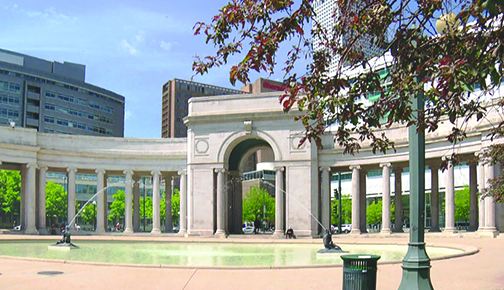
by Mark Smiley | Sep 27, 2021 | General Featured
by Mark Smiley

Closed: Civic Center Park will be closed for at least two months due to it being a violent, drug, and rat infested area. Many Denver residents are upset with the rise in crime and drug use in the area.
The City and County of Denver closed Civic Center Park and adjacent areas to the public in order to abate significant public safety and environmental health risks that have grown over the past several months and to rehabilitate one of the centerpieces of Denver’s parks system.
The park closed on Wednesday, September 15, 2021. According to the city, the park will be restored to a stable and safe state that is welcoming for all Denver residents.
“The current challenges within Civic Center Park have reached a tipping point, creating conditions that put the public’s health and safety at risk,” Mayor Michael B. Hancock said. “This cannot and will not be allowed to continue. This is the people’s park and we are taking steps so that everyone can once again feel safe and welcomed there.”
“We are seeing our city getting overwhelmed by crime and sanitation issues,” said Mike Silverberg, Denver resident. “People are afraid to go downtown an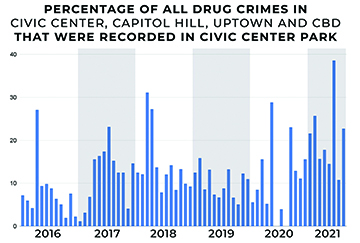 ymore, and now what was a crown jewel park has been fenced off and closed. The latest consequence of Denver’s “friendly” modeling of San Fran, Seattle, and Portland-type policies and acceptance by the silent majority that this is, and growing crime rates, are acceptable.”
ymore, and now what was a crown jewel park has been fenced off and closed. The latest consequence of Denver’s “friendly” modeling of San Fran, Seattle, and Portland-type policies and acceptance by the silent majority that this is, and growing crime rates, are acceptable.”
Over the course of the last several weeks, officials from Denver Public Health & Environment have been monitoring conditions in Civic Center Park, Pioneer Fountain at the corner of Broadway and Colfax, and MacIntosh Park Plaza at 15th Ave. and Cleveland St. for health and environmental hazards which create ongoing unhealthy conditions for all users of the park. Many unsafe conditions were noted, including: litter and food waste that attract bugs and rodents; dozens of rodent burrows; human and pet waste which contribute to the spread of disease and impact water quality; and improperly discarded needles and other drug paraphernalia that creates risks to people v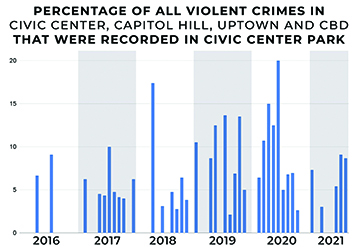 isiting the area and to workers tasked with maintaining the area.
isiting the area and to workers tasked with maintaining the area.
In recent weeks, excessive amounts of trash have accumulated each day, consisting of discarded food, as well as human and hazardous waste, resulting in additional labor hours and rodent infestation. Graffiti and fire damage to the historical stone structures will require professional restoration. A thorough evaluation of the park is also required to ensure all hazardous waste is properly identified and removed.
In addition to the public health risks observed in Civic Center, the park and surrounding areas have become a hotspot for violence, crime, drug sales, and substance misuse, jeopardizing the public’s ability to safely enjoy one of Denver’s treasured outdoor spaces.
The closure is temporary, and Civic Center Park will re-open when abatement measures have been completed and the park is safe for everyone to use. Organizers of scheduled events in Civic Center Park are being contacted for relocation to other park properties.
According to a CBS Denver report, the closure could last as long as two months. The city, however, did not provide any additional information about the timeline of the closure. “When work is complete and all public health issues have been mitigated, Civic Center Park and surrounding areas will be reopened,” read a city press release.

by Regan Bervar | Sep 27, 2021 | Editorials
If anything is good for pounding humility into you permanently, it’s the restaurant business. — Anthony Bourdain
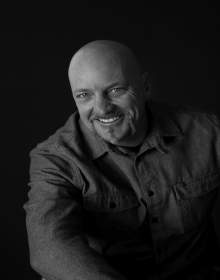 by Luke Schmaltz
by Luke Schmaltz
By the end of 2019, the Mile High City’s hospitality industry was humming at a fever pitch. The slave-wage, cutthroat, desperation-driven, mercenary mindset which has driven this profession for decades was charging forth at full steam. This pulsating, sweat-drenched beast, however, was unaware that it was about to splat face down onto the floor like a piping hot pizza that was dropped by an underpaid line cook who showed up to work sick.

Research by the Colorado Restaurant Association shows restaurant worker employment numbers are below pre-pandemic levels. Colorado Restaurant Association image
By late March of 2020, the industry was being systematically gutted by circumstance. In the span of several very long months, many once-coveted, hard-to-land FOH (front of the house) and BOH (back of the house) positions had become vacant and were up for grabs. The “Great Reopening” had revealed a vacuum in the workforce. Much of the previous labor pool, while locked down and on unemployment, have seemingly discovered other options — perhaps pursuits offering better compensation, lower stress and even (gasp) employee benefits.
Surf’s Down
 In May of this year, at the onset of patio season, the Colorado Restaurant Association reported that nine out of 10 restaurants were having trouble hiring. Meanwhile, the Bureau of Labor Statistics recently reported that between February of 2020 and June of 2021, a restaurant labor pool of 234,500 had recovered to a mere 223,600 — nearly 11,000 workers lower than the previous tally. This begs the question, “Where did they all go?”
In May of this year, at the onset of patio season, the Colorado Restaurant Association reported that nine out of 10 restaurants were having trouble hiring. Meanwhile, the Bureau of Labor Statistics recently reported that between February of 2020 and June of 2021, a restaurant labor pool of 234,500 had recovered to a mere 223,600 — nearly 11,000 workers lower than the previous tally. This begs the question, “Where did they all go?”
In some instances, highly valued, seasoned professionals with years of FOH and/or BOH experience have pivoted and moved onto other pursuits. For example, 14-year Denver industry worker Nolan Ackerman (Southside, Goosetown Tavern) says, “I used the pandemic to finish my bachelor’s and get an internship. I’m out, for now.”
Meanwhile across town, Denver industry veterans and wife/husband team Casey Keller and Roy Benoit have pivoted inward, courageously becoming restaurant owners in late summer of 2020 (Wendell’s, 3838 Tennyson St.) Thus far, attracting qualified help has been somewhat of a challenge, “Overall volume and quality of applicants has been… discouraging,” Benoit explains. When asked about where the talent pool of qualified workers has gone, Benoit has a revealing perspective. “I feel that a lot of previously full-time industry folks often have skills or education that makes them marketable in other fields… and the last year has given many of those people the opportunity and/or impetus to pursue those things,” he begins. “There are certainly some people still collecting unemployment; we’ve physically seen this in people scheduling or coming to interviews for the admitted sole purpose of required work searches. I will say, I feel more of those lingering on unemployment may not be industry ‘professionals,’ if you will, but rather newer or shorter-term industry workers.”
Rather than spend time waiting for external circumstances to improve, however, Keller and Benoit have curated their own strategy for cultivating and maintaining a solid crew. “We believe in paying our people well to begin with and ascribe to quality over quantity when it comes to staffing,” Benoit says. “We currently have a very talented and dedicated staff and have done our best to compensate them accordingly. Now, it is possible we’re shorting ourselves some applicants by not openly advertising above industry norm pay, but even with the current pool, we’d prefer to be choosy and give ourselves the opportunity to pay quality staff what they’re worth and continue to do so.”
On the front lines across Denver, newer industry recruits are having to shoulder heroic workloads as people are coming out in droves to rekindle the beloved American pastime of “going out.” Crews of veritable “newbies” are facing hordes of guests in the FOH and torrents of orders in the BOH that would give the most hardened of veterans the heebie jeebies. In some instances, in order to avoid staff burnout, some establishments are having to cut their hours of operation or to simply remain closed on certain days.
Not Always The Case

Bull & Bush Restaurant/Brewery has largely avoided staffing woes. Image courtesy of David Peterson
Other establishments such as the beloved Bull & Bush on Cherry Creek Dr. have managed to circumvent the labor shortage. Bar-tender Dave Hummel explains the company policy of starting FOH personnel as hosts/hostesses and requiring them to work their way into the higher paying positions of waiting tables and tending bar. This may explain their FOH employee retention rate — even amid the current climate. “The only [labor] shortage we are really having is in the BOH,” he says. Restaurant co-owner David Peterson (with brother Erik) confirms this, saying, “There were a bunch of people chomping at the bit to get back to work. There were a few who opted to stay away and collect unemployment. But, for the most part, we managed to keep most of our staff.” Peterson goes on to explain with a rare tone of optimism, “We have been so busy, unbelievably so, we are breaking record sales.”
This new climate, however, has given rise to a novel phenomenon previously unheard of by most restaurateurs — even a lifelong professional like David Peterson. Recently, an employee of his kitchen staff lobbied for a raise by saying that he could simply go to another restaurant in Cherry Creek and get paid $20 an hour to do far less work because the place would be half as busy. Peterson was unfazed, however, explaining, “Yeah, I get where the guy was coming from. But what he doesn’t realize is that if the place is slow, they might give you the same amount of money, but they are going to cut your hours.”

Bar Car retains a core staff through superior treatment of employees in a preferred establishment in which to work. Jeremy Matzke image
Just across Colorado Boulevard to the North, another long-cherished mainstay establishment has a similar story. Bar Car is a one-of-a-kind blink-and-you’ll-miss-it type of place. Owner Jeremy Matzke believes their company policies helped them deflect the post-shutdown woes. “Speaking strictly from a small, well established locally owned bar, our reputation has held strong, [as] we are a desired place to work,” He begins. “We firmly believe in treating our employees as humans with opinions and feelings and make extra efforts to treat our employees with grace and [as] part of our family … we feel this philosophy is much stronger than most incentives.”
A Nationwide Phenomenon

Former Denver bartender-turned NYC drink slinger Donald Murphy, left, believes the service industry labor shortage is a nationwide problem. Donald Murphy photo
Shifting focus to the nation as a whole, it is becoming clear this is not just a Denver phenomenon — but something possibly taking place from coast to coast. Former Denver bartender Donald Murphy aka “Murph” (Splinters from the Pine, Pasquini’s Uptown) now works as senior drink-slinger and art curator at Upper East Side Manhattan’s esteemed Merrion Square. “This is a nationwide problem,” he attests. “All of the career people who had time off during Covid decided to collect their UI benefits as though they were finally recouping the would-be tips from every time they got stiffed,” he begins. “A lot of people realized, with all that time off, they never really wanted these jobs in the first place. In order to thrive in this industry, you have to truly enjoy serving people, helping guests have a good time, and talking shit with strangers.” Murph goes on to explain that amid the political/presidential madhouse that began in 2016, working in the FOH is not nearly as fun because of a combative, general populace that is divided by social ideals like never before. Many people, when out in public, are either intentionally rude or overly sensitive. This might explain the unattractiveness of the service industry to many entry-level people. “Social division has made working in restaurants and bars not nearly as enjoyable,” he says.
Lopsided Demographics
Back in Denver, the labor shortage seems to be prevalent in some areas and nonexistent in others. For example, many businesses in the LoDo district, the Highlands and the RiNo district are short staffed while outliers in more suburban areas are not. This might also be explained by the average restaurant worker wage compared to the costs of living in these areas. After all, who wants to commute into a congested area, search for parking (if you even have a car), wait on people who live in the neighborhood and make more money than you (entitled a**holes), and then commute back home to your meager dwelling every day?
To combat this, restaurant owners, at least some, are adopting new business models with a variety of adaptations. Some feature higher hourly wages while others offer profit sharing for untipped workers and others are doing the unheard of by offering benefits to part-time, tipped employees. Yesterday’s service industry professionals who have moved on may catch wind of this and be taken aback in utter disbelief. Whether it brings them back into the fold, however, seems rather unlikely — but only time will tell.
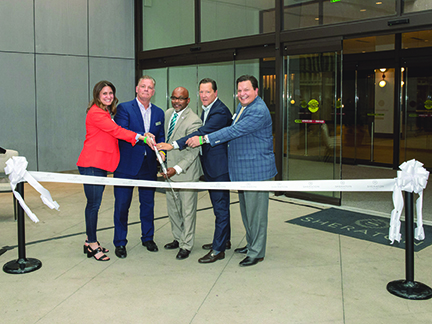
by Mark Smiley | Sep 27, 2021 | Travel
The renovation brings the hotel in line with the future vision for Sheraton Hotels that is being rolled out at properties around the world.
by Mark Smiley

Unveiling Becomes Official: Mayor Michael Hancock cuts the ribbon to unveil the $80 Million renovation to the Sheraton Denver Downtown. From left to right: Rachel Benedick, Executive Vice President, Convention Sales & Services at VISIT DENVER; Tony Dunn, General Manager of Sheraton Denver Downtown; Mayor Michael Hancock; Steve Arnold, Principal at Sea Hospitality; J.J. Ament, CEO of Denver Metro Chamber. Photo by Photography G, Inc.
On September 16, 2021, the Sheraton Denver Downtown Hotel revealed a full-scale renovation of its guest rooms, lobby, public and meeting spaces as part of Sheraton’s worldwide transformation of its guest experience vision. Drawing on its roots as a community hub for locals and guests at flagship locations globally, the new approach for Sheraton creates an intuitive and holistic experience with places to connect and be productive.
“With the Sheraton and the 16th Street Mall, and some other major investments we’re making, we’re gonna fight like hell to make this a place people want to come to and feel safe and enjoy themselves,” said Mayor Michael Hancock, who attended the reopening event. “Denver is proud of its vibrant downtown. And we may have slipped a little bit with some of the challenges we face, but we never give up in the game of being a destination.”
The completion of this $80 million hotel renovation changes the face of the hotel and Denver’s iconic 16th Street Mall. The city of Denver will begin its $150 million renovation of the 16th Street Mall in the next few months. The goal is to make the corridor more walkable and give more outdoor space to businesses that line the street.
Sheraton Denver Downtown Hotel has long been a familiar anchor in Downtown Denver, serving as the largest meetings/ events hotel in the City with roots deep in the local Denver community. The transformation journey is now officially complete, with all aspects of the hotel updated and refreshed — including a new arrival experience, 133,000 square feet of renovated meeting space, and 1,238 newly redesigned guest rooms and 138 suites, as well as a new culinary and beverage experience. Sheraton Denver Downtown Hotel is among the first in the country to undergo the larger brand revitalization that will ultimately transform all future Sheraton hotels.
“We are honored to be one of the first hotels to bring the new Sheraton brand to life in the heart of Denver,” said Tony Dunn, General Manager for the Sheraton Denver Downtown Hotel. “The renovation will serve to highlight what is already incredible about the local Denver community — and bring the best of the Sheraton brand to downtown. As travel starts to resume, these changes will strengthen Denver’s position as a global gathering place for groups, conventions, guests, and locals alike, and will act as a public square for our growing, evolving city.”
The renovation was completed in a phased approach over the last two years. The transformation of Sheraton Denver Downtown Hotel is part of a global project currently being undertaken by Sheraton Hotels & Resorts to bring all of its properties in line with the new vision for the brand, which was first unveiled at the NYU Hospitality Conference in 2018.
For more information, follow the Sheraton Downtown Denver Hotel on social media on Facebook, www.facebook.com/ SheratonDenverDowntown; Twitter, twit ter.com/sheratondendtwn; and Instagram, www.instagram.com/sheratondenver downtown. Visit their website at www. marriott.com/dends.

by Charles Bonniwell | Sep 27, 2021 | Feature Story Bottom Left
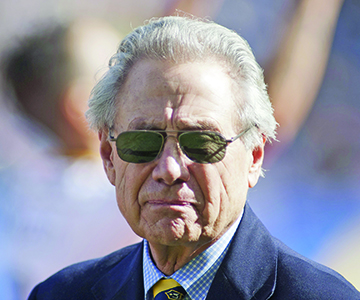
Golden Rule: Phil Anschutz, Colorado’s wealthiest man.
The Colorado Republican Party met down in Pueblo for its fall meeting to consider whether to opt-out of the state run primary. The prominent Democrats had funded statewide referendums called Propositions 107 and 108 back in 2016, which made for Presidential primaries (107) and for open primaries for all others partisan elections (108) whereby unaffiliated voters would receive ballots from both parties and could choose one.
Similar measures had been passed in California and Utah, which mandated acceptance by the parties. Such mandates were found to be unconstitutional in federal courts so this time the provision was made where a political party could opt-out provided 75% of all its State Central Committee (the “SCC”) voted every two years in the fall to do so. Because of its extraordinary high percentage of all members, not just those voting, opting out is almost impossible.
Does this pass constitutional muster? Not according to virtually everyone from conservative legal scholar John Eastman to the liberal Legal Director of the Colorado ACLU Mark Silverstein. A group of grassroot Republicans who are members of the SCC (including the publisher of this paper) began touring the state to convince fellow members of the SCC to vote for opt-out of Proposition 108 at the fall meeting.
The merry band of grassroot activists did not do so because they thought they could achieve the nearly impossible task of getting 75% of all the SCC members to opt-out. In fact, 75% of all the members seldom even attend the fall meeting. The activists did so to get the leadership to act on the issue and bring suit in federal court to determine once all for all the unconstitutionality of Proposition 108.
Somewhat improbably the campaign caught fire and began to attract backers across the state. The Republican SCC is composed of 520 members which includes all state House and Senate legislators who are Republicans as well as the Republican Chair, Vice Chair, and Secretary of each of the 64 counties, as well as bonus members from the more populated counties.
Adherents for the opt-out included State Representatives Dave Williams, Matt Soper, Patrick Neville, Stephanie Luck, and Ron Hanks, former U.S. Congressman Tom Tancredo, Republican National Committeeman and radio host Randy Corporon, State Party Vice Chair Priscilla Rahm, and State Party Secretary Marilyn Harris.
But then came the counterattack from the Republican Party establishment who have controlled the Republican Party for over 20 years, and who dislike the grassroot Republicans more than the farthest left Democrats. The Colorado Republican Party has been, and is, controlled by one person, the state’s richest man, billionaire Phil Anschutz. Very few grassroots Republicans were ever actually aware of this fact.
Anschutz is the owner of the Broadmoor Resort in Colorado Springs, among many other business enterprises, including the NHL’s Los Angeles Kings and Anschutz Entertainment Group (AEG). He also controls the Colorado Springs Gazette newspaper and the blog sites Colorado Politics and the Denver Gazette. He is also rumored to be the biggest contributor to the Denver free market think tank, the Independence Institute, which in turn controls Complete Colorado a news aggregator.
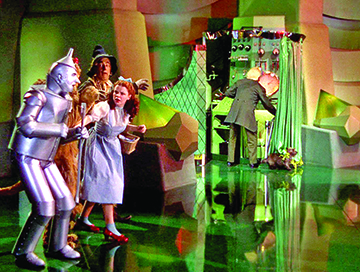
The Discovery: Grassroots Republicans discover that Phil Anschutz is the man behind the curtain in Republican politics.
Anschutz never publicly expresses his political views and works behind the scenes through layers of intermediators. It is believed that he is not a Trump fan, and he is what was once called a “Rockefeller Republican.” His hires for editors and reporters at Colorado Politics and Denver Gazette are almost all left of center liberals and mostly laid off former Denver Post employees. His publications regularly attack grassroot politicians like former State House minority leader Patrick Neville while writing endless puff pieces on moderate Republicans like two-time failed gubernatorial candidate Bob “Both Ways” Beauprez.
The content of his publications tends to be almost no different than The Denver Post except for occasionally having moderate Republicans write opinion pieces. It is believed he has come to accept Democrat hegemony over the state governments of California and Colorado, where most of his business enterprises are located. He has figured out how to have his businesses thrive in such environments.
He clearly didn’t like the opt-out idea and all of a sudden, every one of his publications went on the attack and opposed the opt-out. Even though the Independence Institute’s Jon Caldera is not a Republican and now votes in Democrat primaries, he wrote an editorial condemning the opt-out and then emailed pleas to 520 members of the Republican SCC to vote no on the opt-out. The same for 710 KNUS host Jimmy Sengenberger who has been financially supported by Anschutz organizations. Anschutz even had the Colorado Gazette issue a scathing editorial on the eve of the Republican fall meeting condemning the opt-out vote.
In the end, the opt-out vote failed by a 60% to 40% margin of those attending the fall meeting. It was short of the required 75% of all members of the entire SCC. Ultimately, however, the grassroots won. They were able to get over 75% of the members to attend the fall meeting forcing the State Chair Kristi Burton Brown to even have a vote. Following that failed vote a motion and a resolution were passed almost unanimously demanding the party be a plaintiff to a federal lawsuit to overturn Proposition 108 and set up a separate fund to support such a lawsuit.
Anschutz won the opt-out battle but lost the war. Undoubtedly, Anschutz will try to scuttle the lawsuit too, but it is not clear he will be able to do so. Perhaps, more importantly grassroot Republicans have been able at long last to pull the curtain aside and see who their “Wizard of Oz” opponent really is.


 ymore, and now what was a crown jewel park has been fenced off and closed. The latest consequence of Denver’s “friendly” modeling of San Fran, Seattle, and Portland-type policies and acceptance by the silent majority that this is, and growing crime rates, are acceptable.”
ymore, and now what was a crown jewel park has been fenced off and closed. The latest consequence of Denver’s “friendly” modeling of San Fran, Seattle, and Portland-type policies and acceptance by the silent majority that this is, and growing crime rates, are acceptable.” isiting the area and to workers tasked with maintaining the area.
isiting the area and to workers tasked with maintaining the area.









